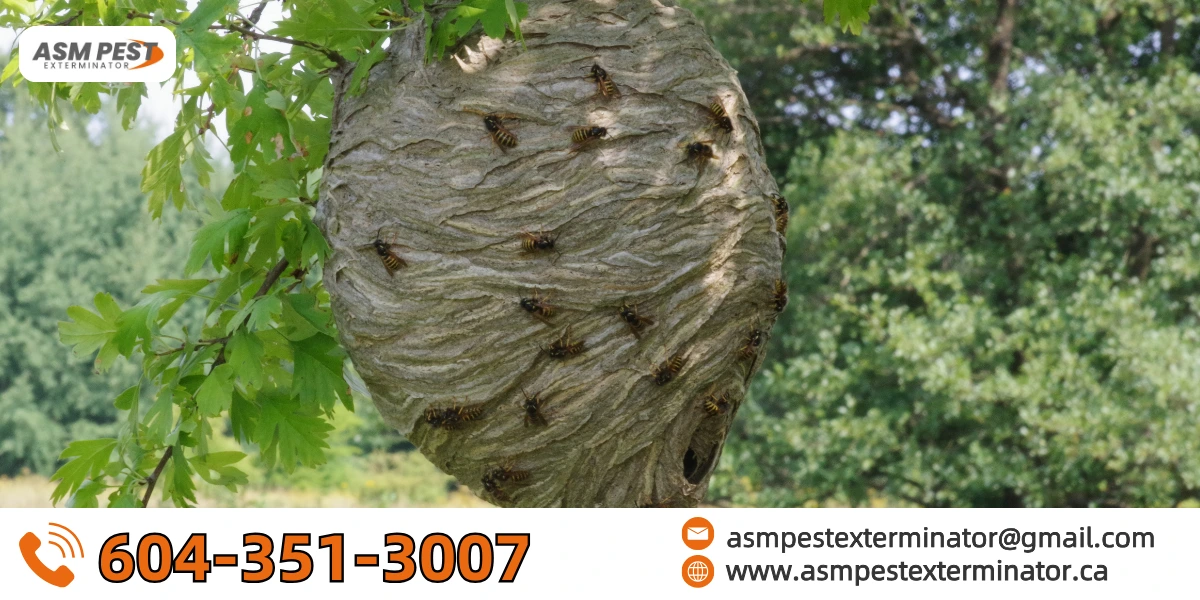When the day of summer comes, people are always frightened by the buzzing of at least one insect, and that is the wasp. They are highly social and territorial insects that could even pose a threat to human lives unless they settle a nest around your household soon before they become a nuisance. But just how many wasps are in a nest, and what influences the size and behavior of these colonies?
This blog touches on the colonies of the wasps, their nesting patterns, life cycle, and how knowledge of this aspect is important in controlling wasp infestations in a safe manner.
Understanding Wasp Colony Sizes
The population within a wasp control Surrey nest will differ greatly depending on the species, the habitat, and the life phase of the colony.
- Paper wasp: The average size of a nest of paper wasps is between 150 and 300 individuals.
- Yellow jacket: Nests can carry a population of 3500 wasps.
- Hornet colonies: The colonies of hornets may increase up to 1500 members.
Factors Influencing Colony Size
- Species: The social species, such as yellow jackets, develop colonies, whereas the solitary species develop nests on their own.
- Season: Colonies of wasps increase during the warm months and attain their greatest numbers in late summer or early fall.
- Place: The colonies grow and develop more quickly in food-rich, safe environments.
- Queen’s health and productivity: The queen creates all eggs; a healthy queen means a larger colony.
The Life Cycle of a Wasp Colony
Wasp control Burnaby colonies goes through a predictable life cycle:
- Spring (Founding Phase): There is only one fertilized queen that gets out of hibernation to found a new nest.
- Early Summer (Growth Phase): Larvae emerge from eggs and develop into worker wasps.
- Late Summer (Peak Population): Colonies can reach hundreds to thousands of individuals.
- Fall (Reproductive Phase): Reproduction of new queens and males, etc. After mating, males drop dead, and the queens find a place to spend the winter when they are fertilized.
- Winter (Dormancy): In winter, the old colony dies, and it commences again the following year.
Why Wasp Infestations Are a Concern
Here are a few reasons:
- Defense: Wasps are territorial and will sting to protect their nest.
- Multiple Stings: Unlike bees, wasps can sting repeatedly, posing a serious risk to those allergic to their venom.
- Structural Damage: Some species build nests inside walls, leading to potential property damage.
- Food Attraction: Wasps are drawn to sugary foods and proteins, increasing their presence around outdoor gatherings.
Preventing Wasp Nest Formation
Below are some ways to prevent wasp control coquitlam nest formation
1. Seal Entry Points
Caulk and seal cracks in walls, window frames, and soffits. Wasps can enter through openings as small as 1/4 inch.
2. Maintain Clean Outdoor Spaces
Cover trash bins, clean up spills promptly, and avoid leaving pet food outdoors.
3. Remove Old Nests
Even inactive nests can attract future queens. Removing them in the winter reduces the risk of new colonies forming in the same area.
4. Trim Vegetation
Cut back trees and bushes near your home, especially around decks and eaves where nests are commonly found.
5. Eliminate Attractants
Reduce populations of insects like flies and spiders, which serve as prey for wasps. This also decreases the food supply that draws them in.
Safe Wasp Nest Removal
It might be tempting to tackle a nest yourself, but wasp control is best left to professionals, especially for large or hidden nests. Experts are trained to identify species and use the appropriate removal techniques and safety gear.
DIY removal attempts can lead to swarming and stings, putting you and others at risk. If you suspect a wasp infestation, always seek professional help.
Related Wasp Behavior Insights
- Social structure: Colonies have a strict caste system: queens, workers, and drones.
- Communication: Wasps use pheromones to signal danger, triggering aggressive responses.
- Territorial nature: They patrol their nests constantly and remember threats.
FAQs
1. How would I know nest is active or not?
Active nests have regular wasp activity, watch for insects flying in and out consistently, especially during daylight.
2. Can we remove a wasp nest at night?
While wasps are less active at night, removal is still risky without proper knowledge and protection. It’s best to call a professional.
3. Where do wasps go in the winter?
Most of the colony dies off, but fertilized queens hibernate in protected areas like attics or tree bark to start new colonies in spring.
Final Thoughts
Understanding how many wasps are in a nest and how their colonies grow is essential for safe and effective wasp management. Whether you’re dealing with paper wasps under your eaves or yellow jackets underground, being informed helps you take the right precautions.
If you suspect an infestation or come across a large nest, don’t take unnecessary risks. Seek professional pest control services to ensure safe removal and prevent re-infestation.




